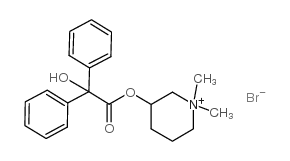Mepenzolate (Bromide)

Mepenzolate (Bromide) structure
|
Common Name | Mepenzolate (Bromide) | ||
|---|---|---|---|---|
| CAS Number | 76-90-4 | Molecular Weight | 420.34000 | |
| Density | N/A | Boiling Point | N/A | |
| Molecular Formula | C21H26BrNO3 | Melting Point | 228-229ºC dec. | |
| MSDS | USA | Flash Point | N/A | |
| Symbol |

GHS07 |
Signal Word | Warning | |
|
Ameliorative effect of mepenzolate bromide against pulmonary fibrosis.
J. Pharmacol. Exp. Ther. 350(1) , 79-88, (2014) Idiopathic pulmonary fibrosis is thought to involve lung injury caused by reactive oxygen species (ROS), which in turn is followed by abnormal fibrosis. A transforming growth factor (TGF)-β1-induced increase in myofibroblast number plays an important role in ... |
|
|
Inflammation stimulates niacin receptor (GPR109A/HCA2) expression in adipose tissue and macrophages.
J. Lipid Res. 55(12) , 2501-8, (2014) Many of the beneficial and adverse effects of niacin are mediated via a G protein receptor, G protein-coupled receptor 109A/hydroxycarboxylic acid 2 receptor (GPR109A/HCA2), which is highly expressed in adipose tissue and macrophages. Here we demonstrate that... |
|
|
Muscarinic cholinergic receptors in human narcolepsy: a PET study.
Neurology 51(5) , 1297-302, (1998) To investigate the function of the muscarinic cholinergic receptor (mAchR) in narcolepsy and the effects of pharmacotherapy on mAchRs.Muscarinic neural transmission serves as the main executive system in REM sleep. Studies in canine narcolepsy reported an inc... |
|
|
[Effect of tiemonium iodide on colonic motility in dogs].
Nippon. Yakurigaku Zasshi. 80(6) , 495-503, (1982) Effects of tiemonium iodide (tiemonium, 20 micrograms/kg), mepenzolate bromide (mepenzolate, 20 micrograms/kg), butylscopolamine bromide (butylscopolamine, 50 micrograms/kg) and atropine sulfate (atropine, 10 micrograms/kg) on the colonic motility in dogs wer... |
|
|
Interaction of the antiarrhythmic drug amiodarone with the muscarinic receptor in rat heart and brain.
J. Cardiovasc. Pharmacol. 6(6) , 1148-55, (1984) The possible interaction between the muscarinic receptor and the antiarrythmic drug amiodarone was studied physiologically in the guinea pig ileum, as well as by competition binding experiments in rat brain and cardiac tissues, using the highly specific triti... |
|
|
Quantitative capillary column gas chromatographic method for the determination of glycopyrronium in human plasma.
J. Chromatogr. A. 308 , 143-51, (1984) A new sensitive and selective capillary column gas chromatographic method for the anti-cholinergic agent glycopyrronium bromide in human plasma is described. The procedure involves preliminary ion-pair extraction of the drug into dichloromethane, followed by ... |
|
|
The effects of aging on the responsiveness of the cholinergic receptor of the longitudinal muscle of guinea-pig isolated ileum.
Res. Commun. Chem. Pathol. Pharmacol. 55(2) , 275-8, (1987) The responsiveness of the cholinergic receptor (ChR) of the longitudinal muscle of guinea-pig isolated ileum was characterized by determining the ED50 of acetylcholine (ACh) and pA2 of mepenzolate (MPZ) in tissues from animals of different ages. The ages of g... |
|
|
Failure to demonstrate effectiveness of an anticholinergic drug in the symptomatic treatment of acute travelers' diarrhea.
J. Clin. Gastroenterol. 5(3) , 223-7, (1983) Seventy adults in the United States with acute diarrhea who were attending classes in Guadalajara, Mexico, enrolled in a double-blind placebo-controlled treatment study of an anticholinergic drug, mepenzolate bromide (MZB). Thirty-five patients received MZB (... |
|
|
Isolation of cholinergic active ingredients in aqueous extracts of Mareya micrantha using the longitudinal muscle of isolated guinea-pig ileum as a pharmacological activity marker.
J. Ethnopharmacol. 45(3) , 215-22, (1995) In our attempt to isolate the pharmacologically active ingredients in the aqueous extracts of Mareya micrantha, we have selected the contractions of the longitudinal muscle of the isolated guinea-pig ileum preparation as a pharmacological marker to monitor re... |
|
|
Atropine and mepenzolate mydriasis in rabbits: a comparative pupillographic analysis of two antimuscarinic agents.
Res. Commun. Chem. Pathol. Pharmacol. 36(3) , 503-6, (1982) The mydriatic effects of mepenzolate, a quarternary antimuscarinic agent, has been investigated and compared with those of atropine by pupillographic analysis in rabbits. The time-response curve for the onset of action for the agents (half-time, ca.5 min) was... |